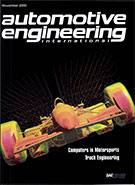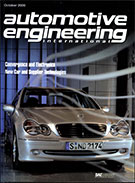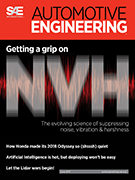Magazine

Automotive Engineering International 2000-11-01
2000-11-01
Getting the aero advantage Team Rahal has come up with several innovative ways of integrating and implementing Fluent Inc.'s computational fluid dynamics softwarae into its engineering process. Jordan Grand Prix benefits from 3-D design This motorsports team's transition from 2-D design to 3-D digital modeling using SDRC's I-DEAS software has resulted in shorter lead times and improved part fit. The 2002 Explorer/Mountaineer Ford engineers further improve ride, handling, and safety while increasing the vehicles' power. Cadillac's re-engineered Escalade The 2002 model has a host of new, advanced features including "Northstar-inspired" powertrains, StabiliTrak stability control, and a Road Sensing Suspension system. Explorer Sport Trac breaks new ground Ford says its 2001 Explorer Sport Trac, based on the 2001 Explorer four-door, was engineered for improved ride and handling, and is the first traditional SUV with an open cargo area.















